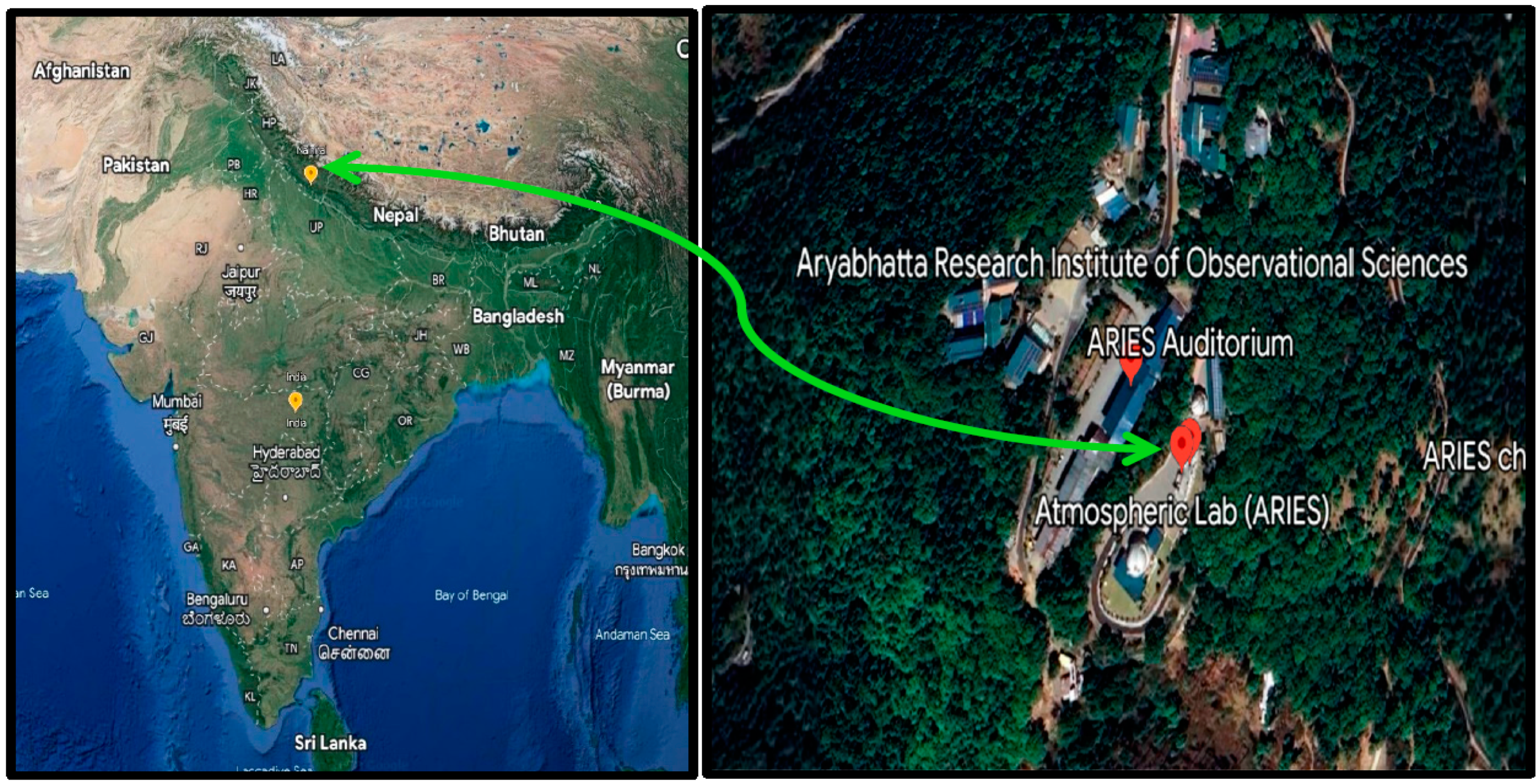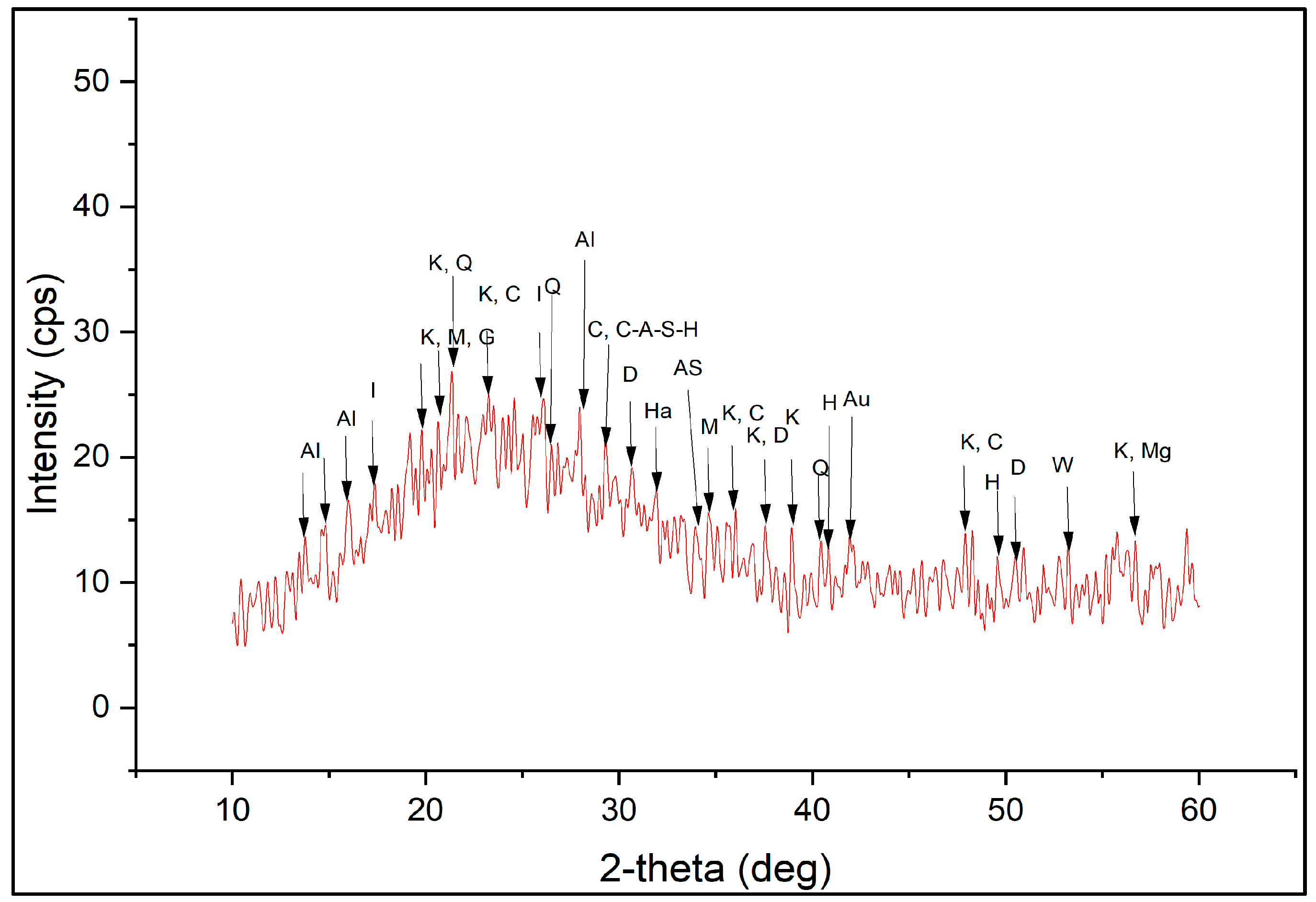Mineralogical Characterization of PM10 over the Central Himalayan Region †
Abstract
:1. Introduction
2. Materials and Methods
2.1. Study Area and Sampling
2.2. X-ray Diffraction Analysis
3. Results and Discussion
3.1. Mineralogical Composition
3.2. Soil-Dust Composition
3.3. Anthropogenic Contribution
4. Conclusions
Author Contributions
Funding
Institutional Review Board Statement
Informed Consent Statement
Data Availability Statement
Acknowledgments
Conflicts of Interest
References
- Yuan, Q.; Wan, X.; Cong, Z.; Li, M.; Liu, L.; Shu, S.; Liu, R.; Xu, L.; Zhang, J.; Ding, X.; et al. In situ observations of light-absorbing carbonaceous aerosols at Himalaya: Analysis of the south Asian sources and trans-Himalayan valleys transport pathways. J. Geophys. Res. 2020, 125, e2020JD032615. [Google Scholar] [CrossRef]
- Yang, J.; Ji, Z.; Kang, S.; Tripathee, L. Contribution of south Asian biomass burning to black carbon over the Tibetan Plateau and its climatic impact. Environ. Pollut. 2021, 270, 116195. [Google Scholar] [CrossRef] [PubMed]
- Rai, A.; Mukherjee, S.; Choudhary, N.; Ghosh, A.; Chatterjee, A.; Mandal, T.; Sharma, S.K.; Kotnala, R. Seasonal transport pathway and sources of carbonaceous aerosols at an urban site of eastern Himalaya. Aerosol Sci. Eng. 2021, 5, 318–343. [Google Scholar] [CrossRef]
- Sharma, S.K.; Choudhary, N.; Srivastava, P.; Naja, M.; Vijayan, N.; Kotnala, G.; Mandal, T.K. Variation of carbonaceous species and trace elements in PM10 at a mountain site in the central Himalayan region of India. J. Atmos. Chem. 2020, 77, 49–62. [Google Scholar] [CrossRef]
- Choudhary, N.; Srivastava, P.; Dutta, M.; Mukherjee, S.; Rai, A.; Kuniyal, J.C.; Lata, R.; Chatterjee, A.; Naja, M.; Vijayan, N.; et al. Seasonal Characteristics, Sources and Pollution Pathways of PM10 at High Altitudes Himalayas of India. Aerosol Air Qual. Res. 2022, 22, 220092. [Google Scholar] [CrossRef]
- Choudhary, N.; Rai, A.; Kuniyal, J.C.; Srivastava, P.; Lata, R.; Dutta, M.; Ghosh, A.; Dey, S.; Sarkar, S.; Gupta, S.; et al. Chemical Characterization and Source Apportionment of PM10 Using Receptor Models over the Himalayan Region of India. Atmosphere 2023, 14, 880. [Google Scholar] [CrossRef]
- Ram, K.; Sarin, M.M. Spatio-temporal variability in atmospheric abundances of EC, OC and WSOC over Northern India. J. Aerosol Sci. 2010, 41, 88–98. [Google Scholar] [CrossRef]
- Sharma, S.K.; Mukherjee, S.; Choudhary, N.; Rai, A.; Ghosh, A.; Chatterjee, A.; Vijayan, N.; Mandal, T. Seasonal variation and sources of carbonaceous species and elements in PM2.5 and PM10 over the eastern Himalaya. Environ. Sci. Pollut. Res. 2021, 28, 51642–51656. [Google Scholar] [CrossRef] [PubMed]
- Jain, S.; Sharma, S.K.; Srivastava, M.K.; Chatterjee, A.; Singh, R.K.; Saxena, M.; Mandal, T.K. Source Apportionment of PM10 Over Three Tropical Urban Atmospheres at Indo-Gangetic Plain of India: An Approach Using Different Receptor Models. Arch. Environ. Contam. Toxicol. 2019, 76, 114–128. [Google Scholar] [CrossRef] [PubMed]
- Bora, J.; Deka, P.; Bhuyan, P.; Sarma, K.P.; Hoque, R.R. Morphology and mineralogy of ambient particulate matter over mid-Brahmaputra Valley: Application of SEM–EDX, XRD, and FTIR techniques. SN Appl. Sci. 2021, 3, 137. [Google Scholar] [CrossRef]
- Neupane, B.B.; Sharma, A.; Giri, B.; Joshi, M.K. Characterization of airborne dust samples collected from core areas of Kathmandu Valley. Heliyon 2020, 6, e03791. [Google Scholar] [CrossRef] [PubMed]
- Kimothi, S.; Chilkoti, S.; Rawat, V.; Thapiyal, A.; Gautam, A.S.; Gautam, S. Micro- to macro-scaling analysis of PM2.5 in sensitive environment of Himalaya, India. Geol. J. 2023, 58, 4360–4378. [Google Scholar] [CrossRef]
- Kumar, S.; Jain, M.K. Characterization and morphometric study of household settled dust: A case study in Dhanbad, the coal capital of India. Appl. Geochem. 2022, 144, 105398. [Google Scholar] [CrossRef]
- Senthil Kumar, R.; Rajkumar, P. Characterization of minerals in air dust particles in the state of Tamilnadu, India through FTIR, XRD and SEM analyses. Infrared Phys. Technol. 2014, 67, 30–41. [Google Scholar] [CrossRef]
- Candeias, C.; Vicente, E.; Tomé, M.; Rocha, F.; Ávila, P.; Célia, A. Geochemical, Mineralogical and Morphological Characterisation of Road Dust and Associated Health Risks. Int. J. Environ. Res. Public Health 2020, 17, 1563. [Google Scholar] [CrossRef] [PubMed]
- Gunawardana, C.; Goonetilleke, A.; Egodawatta, P.; Dawes, L.; Kokot, S. Source characterisation of road dust based on chemical and mineralogical composition. Chemosphere 2012, 87, 163–170. [Google Scholar] [CrossRef] [PubMed]
- Nowak, S.; Lafon, S.; Caquineau, S.; Journet, E.; Laurent, B. Quantitative study of the mineralogical composition of mineral dust aerosols by X-ray diffraction. Talanta 2018, 15, 133–139. [Google Scholar] [CrossRef] [PubMed]


| Mineral | Chemical Composition | 2θ |
|---|---|---|
| Quartz | SiO2 | 20.64, 26.50, 40.46 |
| Dolomite | (Ca, Mg (CO3)2) | 30.70, 37.56, 50.52, 50.94 |
| Augite | (Ca, Mg, Fe)2Si2O6 | 19.80, 30.70, 34.64, 40.46, 40.84, 41.92, 49.56 |
| Albite | Na(AlSi3O8) | 13.74, 14.74, 15.96, 23.28, 24.60, 27.96, 53.26 |
| Calcite | CaCO3 | 23.28, 29.36, 36.06, 47.88, 48.30 |
| Kaolinite | Al2O3·2SiO2·2H2O | 19.80, 20.64, 21.34, 23.28, 24.60, 36.06, 37.56, 38.96, 40.46, 40.85, 47.88, 52.72, 55.22, 56.74 |
| Illite | (K, H3O+) (Al, Mg, Fe)2(Si, Al)4O10[(OH)2, (H2O)] | 17.36, 26.82 |
| Montmorillonite | (Na,Ca)0.3(Al,Mg)2SiO4(OH)2·nH2O | 19.80, 21.34, 34.64 |
| Magnetite | Fe3O4 | 56.74 |
| Hematite | Fe2O3 | 40.84, 49.56 |
| Gypsum | CaSO4·2H2O | 20.64, 23.28 |
| Halite | NaCl | 31.88, 56.74 |
| Mascagnite | (NH4)2SO4 | 20.64, 29.36, 34.64, 38.96 |
| Wollastonite | CaSiO3 | 23.28, 51.96, 53.26 |
| C-A-S-H | Ca12Al2Si18O51(OH)2·18H2O | 29.36 |
Disclaimer/Publisher’s Note: The statements, opinions and data contained in all publications are solely those of the individual author(s) and contributor(s) and not of MDPI and/or the editor(s). MDPI and/or the editor(s) disclaim responsibility for any injury to people or property resulting from any ideas, methods, instructions or products referred to in the content. |
© 2023 by the authors. Licensee MDPI, Basel, Switzerland. This article is an open access article distributed under the terms and conditions of the Creative Commons Attribution (CC BY) license (https://creativecommons.org/licenses/by/4.0/).
Share and Cite
Gupta, S.; Srivastava, P.; Naja, M.; Choudhary, N.; Sharma, S.K. Mineralogical Characterization of PM10 over the Central Himalayan Region. Environ. Sci. Proc. 2023, 27, 10. https://doi.org/10.3390/ecas2023-15923
Gupta S, Srivastava P, Naja M, Choudhary N, Sharma SK. Mineralogical Characterization of PM10 over the Central Himalayan Region. Environmental Sciences Proceedings. 2023; 27(1):10. https://doi.org/10.3390/ecas2023-15923
Chicago/Turabian StyleGupta, Sakshi, Priyanka Srivastava, Manish Naja, Nikki Choudhary, and Sudhir Kumar Sharma. 2023. "Mineralogical Characterization of PM10 over the Central Himalayan Region" Environmental Sciences Proceedings 27, no. 1: 10. https://doi.org/10.3390/ecas2023-15923
APA StyleGupta, S., Srivastava, P., Naja, M., Choudhary, N., & Sharma, S. K. (2023). Mineralogical Characterization of PM10 over the Central Himalayan Region. Environmental Sciences Proceedings, 27(1), 10. https://doi.org/10.3390/ecas2023-15923







